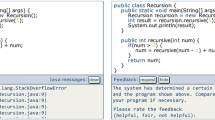Abstract
SIAM is a model-based expert system designed for diagnosis aid with training in mind. SIAM is meant for students in higher education (polytechnic or university level) confronted with technical problems during practical work. Its aim, on the one hand, is to help the student on the spot, as quickly as possible and, on the other hand, to make him rapidly autonomous in his operations by teaching him a diagnosis method. The system is adaptable to various kinds of laboratory equipment in different fields of application: electronics, optics and mechanics. In this context, designing an intelligent tutoring system implies providing advanced technical and pedagogical abilities. Several levels of metaknowledge are required, which enable it, on the one hand, to be as independent as possible of its fields of application, and on the other hand, to describe in a pedagogical and relevant way, the key steps of the cognitive process followed by the experts. Most of the knowledge is represented by using models and descriptives. The advantages of this approach are both technical and pedagogical, by allowing easier acquisition of knowledge, reusability of the models and construction of relevant explanations about the diagnosis methodology. Maintenance aspects have also been considered so that the evolution of the system can be directly monitored by the teachers. A series of experiments using SIAM enabled us to measure its impact on the students and to evaluate our design choices.
Access this chapter
Tax calculation will be finalised at checkout
Purchases are for personal use only
Preview
Unable to display preview. Download preview PDF.
Similar content being viewed by others
References
Anderson, J.R.: The Expert Module. Foundations of Intelligent Tutoring Systems, p. 21–53. LEA. Hillsdale. New Jersey. 1988
Brown, J.S., Burton, R.R.: Multiple representations of Knowledge for tutorial reasoning (SOPHIE). Representation and understanding. Academic Press.New York. 1975
Brown, J.S., Burton, R.R., De Kleer, J.:Pedagogical, natural language and knowledge engineering techniques in SOPHIE I,II, III. Xerox Palo Alto Research Center. 1981
Burton, R.R.: The Environment Module of Intelligent Tutoring Systems. Foundations of Intelligent Tutoring Systems. p. 109–142. LEA. Hillsdale. New Jersey. 1988
Clancey WJ.: Methodology for Building an Intelligent Tutoring System. Method and Tactics in Cognitive Science. Kintsch, Miller & Polson Editors. Hillsdale. 1984
Clancey W.J.: From Guidon to Neomycin and Heracles in Twenty Short Lessons. ONR Final Repon 1979–1985. Stanford Knowledge Systems Laboratory. 1986
Courtois J.: Système intelligent pour I’apprentissage du diagnostic technique. Congrès ITS 88. Montreal. 1988
Courtois, J.: Les apports de I’informatique dans la formation du raisonnement scientifique appliqué. Colloque “Les finalités de I’enseignement scientifique en question”. Marseille. 1989
Courtois J.: Gestion d’expenises multiples dans un système de diagnostic - Le système SIAM. 9e Journées Intemationales d’Avignon. 1989
Courtois J.: SIAM: un système de diagnostic qui s’adapte aisément à de nouveaux domaines et qui enseigne sa méthode. Thèse Doctoral de I’Université Paris VI. 1990
Dague, P., Devès, P., Raiman, O.: Troubleshooting: when modeling is the trouble. AAAI 1987. Seattle. 1987
De Kleer, J., Williams, B.C.: Diagnosis with Behavioral Modes. 11th UCAI 89, p. 1324–1330. 1989
Lainière, J.L.: Intelligence Artificielle (tome2) Représentation des connaissances. Eyrolles. Paris. 1988
Marrakchi, M.: Représentation des connaissances pour l’aide au diagnostic industriel: application au système expert S.E.DIAG. Thèse de Docteur Ingénieur. Université de Valenciennes. 1986
Moustafiadès, J.: Formation au diagnostic technique: l’apport de l’intelligence artificielle. Masson. Paris. 1990
Nicaud, J.F., Vivet, M.: Les tuteurs intelligents: réalisations et tendances de recherches. TSI vol.7, no.l. 1988
Paliès, O.: Métaconnaissance pour la modélisation de l’élève. Contribution au diagnostic cognitif par système expert Thèse de Doctorat d’Université. Université Paris VI. 1988
Pitrat, J.: Métaconnaissance, Futur de l’Intelligence Artificielle. Hermès. Paris. 1990
Reiter, R.: A Theory of Diagnosis from First Principles. Artificial Intelligence 32, p. 57–95.1987
Raiman, O.: Order of magnitude reasoning. AAAI 1986, p. 100–104. Philadelphia. 1986
Raiman, O.: Diagnosis as a trial: The alibi principle. Model Based Diagnosis International Workshop, July 25–27. Paris. 1989
Vivet, M., Futtersack, M., Labat, J.M.: Métaconnaissances dans les tuteurs intelligents. Congrès ITS 88. Montréal. 1988
White, B.Y., Frederiksen, I.R.: Qualitative models and intelligent learning environments. Artificial Intelligence and Education. Ablex Publishing Corporation Norwood. 1987
Woods, W.A.: Transition network grammars for natural language analysis. Communications of the ACM vol.13. 1970
Yazdani, M.: Intelligent Tutoring Systems: an overview. Artificial Intelligence and Education.Ablex Publishing Corporation.Norwood. 1987
Author information
Authors and Affiliations
Editor information
Editors and Affiliations
Rights and permissions
Copyright information
© 1992 Springer-Verlag Berlin Heidelberg
About this paper
Cite this paper
Courtois, J. (1992). Practical Work Aid: Knowledge Representation in a Model Based AI System. In: Tiberghien, A., Mandl, H. (eds) Intelligent Learning Environments and Knowledge Acquisition in Physics. NATO ASI Series, vol 86. Springer, Berlin, Heidelberg. https://doi.org/10.1007/978-3-642-84784-4_3
Download citation
DOI: https://doi.org/10.1007/978-3-642-84784-4_3
Publisher Name: Springer, Berlin, Heidelberg
Print ISBN: 978-3-642-84786-8
Online ISBN: 978-3-642-84784-4
eBook Packages: Springer Book Archive




